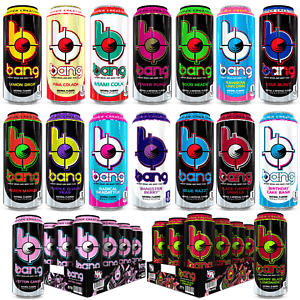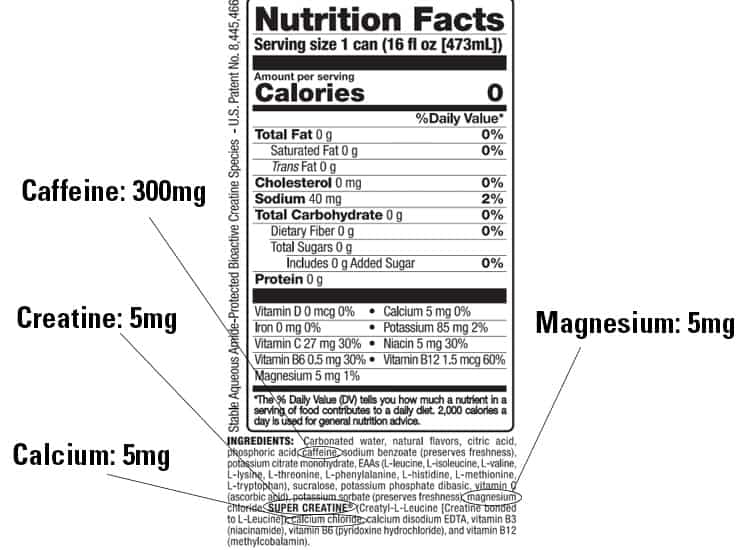
Bang energy drinks from VPX are some of the most popular on the market today. When an energy drink transcends the supplement industry and starts to pop up in supermarkets and convenience stores, you know they are successful.
Bang started out as a carbonated energy drink in a variety of flavors, and now features tea and mini versions.
What separates Bang from other energy drinks is its inclusion of popular supplement ingredients like essential amino acids, CoQ10, and creatine.
Seasoned supplement users know about the myriad of benefits with creatine. But they also know creatine is unstable in liquid. Bang energy drinks feature a form of creatine bonded with the amino acid L-leucine, which supposedly keeps the creatine intact in liquid.
The question then arises of how much creatine is in a can of Bang. Bang’s supplement facts panel features a proprietary blend of ingredients at the bottom. A proprietary blend tells you what ingredients are in the product, but not in what amounts.
However, with some simple reasoning, we can figure out how much creatine is in Bang. To do this you just need a basic understanding of how things are labeled.
The FDA requires that all ingredients be listed in order of potency and concentration. So the first ingredient listed has the greatest amount, and the final ingredient has the lowest concentration. As a result, you will see the first ingredient in any energy drink be water or carbonated water. The last will likely be some sort of sweetener or vitamin, as those are usually measured in milligrams or even micrograms.
For reference, an efficacious dose of creatine is about 5,000mg. Bang explicitly notes that the caffeine content in one can is 300mg, and creatine falls below caffeine on the label. Going further down we see magnesium in the proprietary blend, which is also listed elsewhere on the label as 5mg.
On the Bang label, creatine is listed between magnesium and calcium, both of which are distinctly noted as having 5mg on the label. From this we can decipher that Bang contains 5mg of creatine as well, far below the recommended dose of 5,000mg. This is under the premise that the product has been accurately labeled.

This practice is known in the supplement industry as pixie dusting, which means to put ingredients in a proprietary blend that look good on paper, but are far below what an efficacious dose would be. You often see it in pre workout formulas and greens powders.
Why do this? Many consumers aren’t educated on this idea. They see things like creatine, CoQ10, and essential amino acids on the front of the product, and just assume they’re getting these ingredients in proper doses.
However, some supplement users are aware of this and will completely avoid any product that contains a proprietary blend. For reference, the FDA labeling rules apply across the board. Food, drink, and supplement ingredients are supposed to be labeled in order from greatest to least amount.
In fairness, most people aren’t drinking Bang for the creatine. They’re drinking it because it provides energy and tastes good. Also, they haven’t technically done anything wrong. The product does technically contain creatine, just not in an amount that would provide any benefit. It’s misleading, but not incorrect.
However, if you’re someone who supplements with creatine on a regular basis, and also drinks Bang, it’s important information. You may drink Bang thinking your creatine needs are taken care of for the day, but in reality they’re not.
On days you drink Bang you should still continue taking additional creatine in other forms, whether on its own or as part of a pre workout formula, since Bang won’t provide nearly enough to keep muscles saturated. 5,000 mg (usually listed as 5g) is the standard dose for creatine maintenance.
A separate issue is creatine’s stability. Creatine is unstable in water after a period of time. Obviously, if you mix creatine in a shaker bottle and drink it a few minutes later you’re fine. But if you were to leave it mixed, eventually it would degrade.
Bang energy drinks are pre-made and potentially could sit on shelves for months. The creatine in Bang is bonded to leucine, which supposedly keeps it stable, but we were unable to find any clinical research supporting this.
Creatine is considered one of the most effective and well-researched supplement ingredients. It helps increase strength, muscle volume, and anaerobic energy.
The reason you need to take creatine every day is because it is stored in muscle tissue, like a fuel tank. Taking creatine daily ensures that the muscle creatine stores are maxed, which means the user can experience the full benefit.
Given the research on both safety and benefit, creatine is inexpensive relative to other supplements. Creatine monohydrate is the most common form and has been shown to fully saturate muscles.
Recent Posts
Stretching Before Workouts: Essential Warmup or Performance Killer
“Don’t stretch before workouts, your muscles become too supple” “Stretch before your workouts, warming up is important” It's conflicting advice like this that drives people crazy,...
Best Protein Bar For the Money | Cost Effective, High Quality
Protein bars are no longer a supplement dedicated to diehard gym rats, with awful taste and the consistency of a brick. Men, women, and even teenagers can commonly be seen eating protein bars. The...
